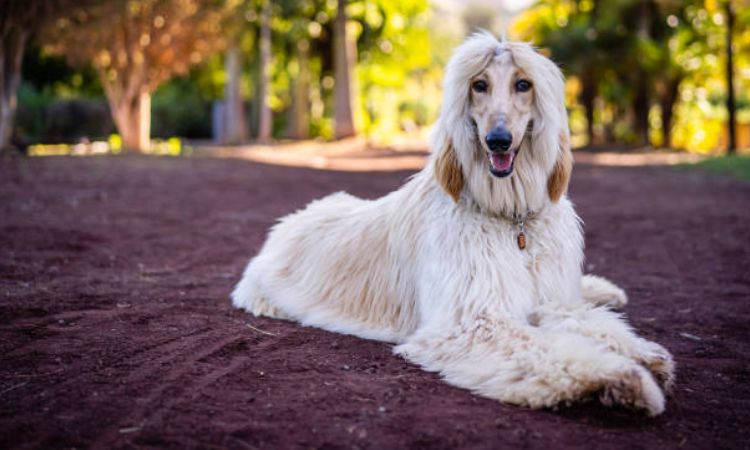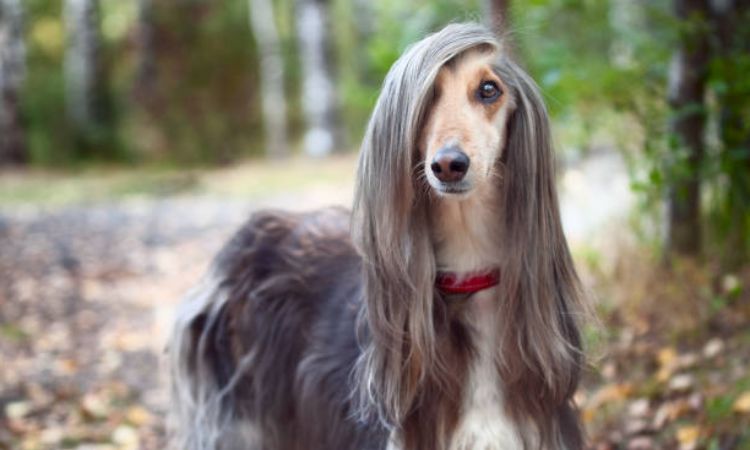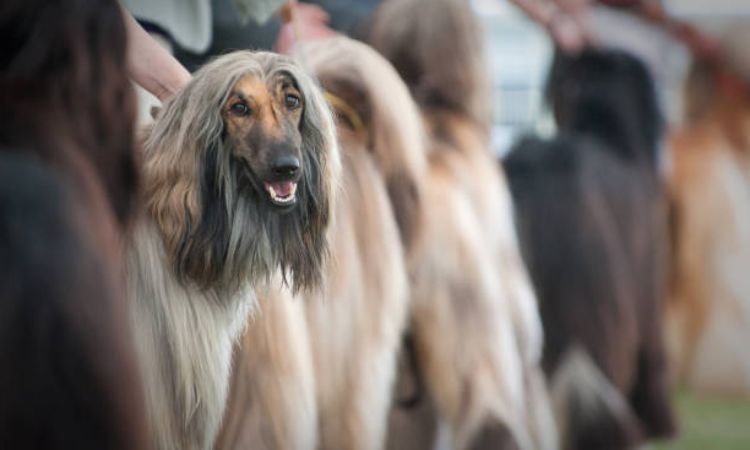Imagine a dog that moves like liquid silk, with a gaze that feels both mysterious and wise this is the Afghan Hound. Far more than just a striking coat and elegant posture, these dogs carry an independent spirit and a playful charm that can surprise even the most seasoned dog lovers.
From their lofty Afghan mountains roots to their place in modern homes, Afghan Hounds are a captivating blend of beauty, brains, and personality. Dive in to explore everything you need to know about Afghan Hound price, temperament, and size in your ultimate breed guide.
History and Origin
The Afghan Hound is one of the oldest known dog breeds, with roots tracing back thousands of years. While its most widely accepted origin is the mountainous regions of Afghanistan, some historical evidence also suggests connections to northern India and Pakistan, with a lesser-known theory proposing links to the Sinai Peninsula. Locally, these dogs were called Sag-e Tāzī in Dari or Tāžī Spay in Pashto. Over centuries, isolated mountain valleys preserved the breed’s purity, keeping it free from crossbreeding with other dogs. Genetic studies classify the Afghan Hound as a basal breed, meaning it predates most modern dog breeds and shares ancestry with other ancient sighthounds like the Saluki.

Afghan Hounds were originally bred as sighthounds for hunting in the challenging terrain of Afghanistan. Their primary quarry included gazelles, wild goats, and other small to medium-sized game, requiring the dogs to possess exceptional speed, agility, and endurance. The breed’s iconic long, silky coat was not merely decorative—it evolved as a natural protection against harsh mountain climates, insulating the dog from both cold and heat. Additionally, their large, well-padded feet acted as shock absorbers, allowing them to traverse rocky and uneven terrain with ease.
The combination of ancient lineage, hunting prowess, and unique physical adaptations made the Afghan Hound a highly valued companion and hunting partner among tribal chieftains in Afghanistan, laying the foundation for the glamorous yet athletic breed known worldwide today.
Afghan Hound Price: What Does an Afghan Hound Cost?
Initial Puppy Price Breakdown
Afghan Hound puppies from reputable breeders typically cost $2,000–$3,000, though prices can vary widely depending on several key factors:
- Show Quality vs. Pet Quality:
- Show-quality puppies are bred to meet breed standards and compete in dog shows. They usually command higher prices due to their conformation, pedigree, and training potential.
- Pet-quality puppies are still healthy, purebred Afghan Hounds, but may not meet strict show criteria. They are often more affordable while remaining loving companions.
- Champion Bloodlines: Puppies descended from champion show dogs or award-winning bloodlines often carry a premium price, reflecting their potential for competitive success and genetic desirability.
Adoption & Rescue Costs
For those considering an Afghan Hound without purchasing from a breeder, adoption can be a more affordable and ethical option:
- Rescue Fees: Afghan Hound rescue groups typically charge $500–$1,000, which may include vaccinations, spay/neuter surgery, and microchipping.
- Pros and Cons:
- Adopting helps give a home to a dog in need and reduces overall cost, though the dog’s age, previous training, or health history may vary.
- Buying from a breeder ensures predictable temperament, age, and health background but comes with a higher upfront cost.
FAQ: Is it better to buy or adopt an Afghan Hound?
It depends on your priorities. If you want a puppy from a known bloodline with a guaranteed pedigree, buying may be preferable. If your goal is to rescue a dog and save a life, adoption is an excellent choice. Both paths require dedication to training, care, and grooming.
Lifetime Financial Commitment
Owning an Afghan Hound goes beyond the initial purchase or adoption. Consider the ongoing costs of keeping your dog healthy, happy, and well-groomed.
- Grooming:
Afghan Hounds have long, silky coats that require regular maintenance.- Professional grooming: $75–$150 per session, 4–6 times per year depending on coat length and maintenance.
- At-home supplies: Brushes, combs, shampoos, and conditioners can cost $100–$300 annually. Grooming is one of the largest recurring expenses for this breed.
- Food:
- Afghan Hounds need a high-quality, well-balanced diet appropriate for their age and activity level. Recommended brands include Purina®, Hill’s®, and Royal Canin®.
- Annual food costs may range from $600–$1,200, depending on the dog’s size and activity.
- Veterinary Care & Health Insurance:
- Routine vet visits, vaccinations, and preventive care average $500–$800 per year.
- Health insurance for Afghan Hounds can help mitigate costs associated with conditions like chylothorax, bloat, or orthopedic issues, averaging $400–$600 annually.
Other potential costs include training classes, enrichment toys, and emergency medical expenses, which can vary based on lifestyle and location.

Afghan Hound Personality & Temperament
The Afghan Hound is a breed of contrasts—aloof yet affectionate, independent yet loyal, dignified yet playful. Understanding its personality is key to providing the proper care, training, and socialization.
Key Traits
- Independent Thinker: Afghan Hounds were bred as hunters who could make quick decisions in the field. This independence often translates to a stubborn streak, meaning they may ignore commands if they don’t see the point.
- Reserved & Aloof: They tend to be cautious with strangers and unfamiliar situations. Unlike overly anxious breeds, Afghans are aloof by choice—they observe first and engage on their own terms.
- Loyal & Loving With Family: Though selective about whom they bond with, Afghan Hounds show deep affection and loyalty to their family. They often choose a “favorite person” but enjoy interacting with the household as a whole.
- Playful & Clownish: Despite their aristocratic appearance, Afghans have moments of silliness and enjoy playful interactions, particularly in a safe, familiar environment.
- High Prey Drive: As sighthounds, they may chase small animals like squirrels, rabbits, or even cats. Proper early socialization is essential to prevent problematic behaviors.
- Sensitive & Intelligent: Afghan Hounds respond best to gentle guidance and positive reinforcement. Harsh corrections can make them resistant to training.
Behavior at Home
- With Children: Can be good with kids if properly supervised and taught boundaries, especially given their prey instincts.
- With Other Pets: Early socialization is crucial. They can coexist with other dogs and pets if trained, but their hunting instincts should always be monitored.
- Vocalization: Afghan Hounds are generally quiet dogs and not prone to excessive barking.
Training Tips
- Consistency is Key: Afghan Hounds need patient, persistent training.
- Positive Reinforcement: Food rewards or praise work best, sometimes “tricking” them into desired behaviors.
- Early Socialization: Introduce puppies to a variety of people, pets, sounds, and environments.
- Exercise: Regular walks, runs, or dog sports (like lure coursing or agility) help channel energy productively.
Afghan Hounds are regal, independent, and loving dogs for owners who understand their unique needs. They thrive in environments that offer gentle training, consistent routines, ample exercise, and social exposure. For the right family, they are loyal, affectionate, and endlessly entertaining companions.
Afghan Hound Weight, Size, and Appearance
Official Breed Standard Size (AKC)
- Height:
- Male: 27 inches (≈68 cm) at the withers
- Female: 25 inches (≈64 cm) at the withers
- Weight:
- Male: 55–65 lbs (25–29 kg)
- Female: 45–55 lbs (20–25 kg)
- These ranges reflect a healthy, mature Afghan Hound.
Breed Note: The Afghan Hound’s prominent hip bones are a natural characteristic of the breed, providing agility and balance, and are not a sign of malnutrition.
The Signature Afghan Hound Coat
- Texture and Length:
- Long, fine, silky coat covering most of the body
- Shorter, glossy hair on the face and back (saddle)
- Distinctive topknot of long hair around the head and ears
- Coat flows elegantly during movement, highlighting the breed’s grace
- Acceptable Coat Colors:
- Virtually any solid color or combination is permitted, including black, cream, red, fawn, gold, blue, brindle, gray, and tricolor
- Cream and red coats may feature black masks
- White markings are generally discouraged in show standards
Key Physical Features
- Exotic/Oriental Expression: Almond-shaped, dark eyes give a keen, gazelle-like appearance
- Prominent Hip Bones: Essential for balance and the breed’s characteristic agile, springy gait
- Strong, Arched Neck:
- Adds to the regal, elegant posture
- Supports a long head and flowing mane, emphasizing the Afghan Hound’s aristocratic presence
- Additional Traits:
- Long, flexible legs and large, padded feet for shock absorption on rugged terrain
- Tail ending in a small ring curl, completing the breed’s distinctive silhouette
Health and Care Guide

Grooming: Maintaining the Luxurious Coat
Afghan Hounds have long, silky hair that sets them apart, but this beautiful coat demands consistent care to prevent tangling and matting.
- Daily Brushing: A few hours per week are typically recommended. Use a pin brush and comb to gently detangle hair and distribute natural oils. Regular brushing is crucial, as mats can form quickly due to the fine texture of the coat.
- Bathing: Weekly or bi-weekly baths are ideal. Use a gentle dog shampoo and follow with blow-drying to keep the coat smooth and conditioned.
- Other Care: Afghan Hounds require routine attention for overall hygiene:
- Dental Care: Brush teeth several times a week to prevent tartar and dental disease.
- Nail Trims: Keep nails short to avoid discomfort and gait issues.
- Ear Care: Inspect ears frequently for wax buildup or infection, especially given their long, folded structure.
Some owners use a snood—a fabric covering for the head and ears—to keep hair clean during mealtimes.
Exercise Needs
Despite their aristocratic demeanor, Afghan Hounds are highly active and need regular exercise to remain healthy and well-behaved.
- Daily Activity: Long walks, jogs, or runs are essential. They thrive on structured play and off-leash running in safely enclosed areas.
- Fencing Considerations: Afghan Hounds are excellent jumpers with a strong prey drive. A secure, high-fenced yard is necessary to prevent escapes and protect them from danger.
- Canine Sports: Engage them in activities that challenge both mind and body, such as:
- Lure Coursing – Simulates hunting and satisfies natural instincts.
- Agility Training – Improves coordination and provides mental stimulation.
- Obedience and Rally Sports – Reinforces focus and strengthens the bond with their owner.
Common Afghan Hound Health Issues
Afghan Hounds are generally healthy, but potential health problems can occur, some related to their anatomy or genetics:
- Hip and Elbow Dysplasia: Malformation of joints that may lead to arthritis or mobility issues. Responsible breeders screen for these conditions.
- Hypothyroidism: Reduced thyroid hormone production can affect metabolism, coat quality, and energy levels.
- Eye Problems: Juvenile cataracts and other ocular conditions can impact vision; routine veterinary eye exams are recommended.
- Sensitivity to Anesthesia: Like other sighthounds, Afghan Hounds have low body fat, making them more susceptible to complications during anesthesia. Always inform your veterinarian of breed-specific considerations.
- Bloat (Gastric Dilation-Volvulus): Due to their deep chests, Afghan Hounds are at risk for bloat, a life-threatening condition. Feed smaller meals and avoid intense activity immediately after eating.
Owning an Afghan Hound requires commitment to grooming, exercise, and preventive health care. When properly cared for, these dogs are elegant, loyal, and athletic companions. Their high-maintenance coat, active lifestyle, and health sensitivities mean that prospective owners must be prepared to invest time, energy, and knowledge into their care.






